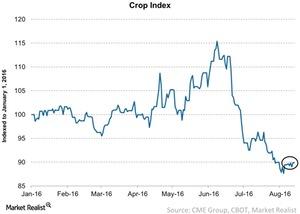Corn, Soybean, and Wheat Prices Fall in August, but Why?
On August 13, the crop index stood at 89.9. It rose by 1% following the USDA’s latest stock-to-use ratio, which was published on August 12.
Nov. 20 2020, Updated 12:20 p.m. ET

The crop index
Each month around this time, the USDA (United States Department of Agriculture) issues a report on a global stock-to-use ratio for key crops. This ratio essentially shows the level of global carryover stock remaining as a percentage of total global use of a crop commodity.
The stock-to-use ratio has an impact on crop prices, which were much lower on August 13 than the beginning of the year. They have remained mostly below their past five-year prices.
Crop index level
The crop price index[1. a median of historical spot prices of key NPK-consuming crops: corn, wheat, soybean, and rice] reached its peak of slightly above 115 in June 2016, but it has fallen since then.
On August 13, the crop index stood at 89.9. It rose by 1% following the USDA’s latest stock-to-use ratio, which was published on August 12. However, the crop index fell by ~6.7% month-over-month. This highlighted extended weakness in the agricultural environment (MOO).
How does this impact fertilizers?
Low crop prices raise concerns about the recovery in the fertilizer sector. Low crop prices mean lower farm incomes. This pressures farmers to rethink their operating expenses, including fertilizers and seeds. Companies such as Monsanto (MON) and Syngenta (SYT) are impacted by this. In 2015, fertilizers represented 41% of the operating costs for corn in the US, according to the USDA.
Net farm income in 2015 fell by 38%, according to the USDA. Fertilizers’ average dollars per planted acre for wheat, corn, and soybeans declined by 7.8%, 7.1%, and 6.5%, respectively, in 2015. A decline in average fertilizer dollars per planted acre doesn’t always mean lower fertilizer consumption.
Fertilizers such as nitrogen must be applied every year, although this isn’t the case for phosphate and potash. Nitrogen fertilizer shipments increased in the recent quarter for companies such as CF Industries (CF), PotashCorp (POT), Terra Nitrogen (TNH), and Agrium (AGU).
The average realized prices of fertilizers have fallen significantly in 2016. Please read our latest fertilizer price update report, How Fertilizer and Raw Material Prices Moved Last Week.
